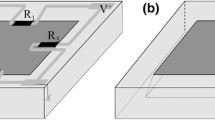Abstract
Micro electro mechanical system are highly miniaturized devices combining both electrical and mechanical components that are fabricated using integrated circuit batch processing techniques. P-type piezoresistors are diffused into the diaphragm in such a way that two of them are arranged parallel to the membrane edge and the other two are arranged perpendicular to the edge. The results reported in the literature evaluates the sensitivity by considering the change in the dimension of piezoresistors. But this work evaluates sensitivity and noise immunity of the piezoresistors by considering the change in the dimension of piezoresistors and the doping concentration when the sensor is being operated over a temperature ranging from 100 to 600 K. Various thermal effects are considered in the studies to evaluate the noise immunity. The simulation results clearly indicate that the dimension and doping concentration of piezoresistors play an important role in determining the sensitivity of the pressure sensor. It is found that the piezoresistor that senses the compressive plays an integral part in determining the sensor sensitivity. To have a better noise immunity, the doping concentration of the piezoresistor should be high if the sensor needs to operate at high temperatures else, the doping concentration should be low.









Similar content being viewed by others
References
Arora ND, Hauser JR, Roulston DJ (1982) Electron and hole mobilities in silicon as a function of concentration and temperature. IEEE Trans Electron Devices 29:292–295
ATLAS User’s Manual (2006) Silvaco International
Bao M, Wang Y (1987) Analysis and design of a four-terminal silicon pressure sensor at the center of a diaphragm. Sen Actuators 12:49–56
Caughey DM, Thomas RE (1967) Carrier mobilities in silicon empirically related to doping and field. Proc IEEE 55:2192–2193
Chaurasia S, Chaurasia BS (2012) Analytical models for low pressure square diaphragm piezoresistive MEMS sensor engineering and systems (SCES), IEEE 2012, pp 1–6, 16–18 March 2012
Clausen I, Sveen O (2007) Die separation and packaging of a surface micro machined piezoresistive pressure sensor. Sens Actuator A 133:457–466
Gong S-C, Lee C (2001) Analytical solutions of sensitivity for pressure micro sensors. IEEE Sens J 1(4):340–344
Jevti MM, Smiljani MA (2008) Diagnostic of silicon piezoresistive pressure sensors by low frequency noise measurements. Sens Actuators A 144:267–274
Linlin Z, Chen X, Guangdi S (2006) Analysis for load limitation of square-shaped silicon diaphragms. Solid State Electron 50:1579–1583
Madhavi KY, Krishna M, Murthy CSC (2013) Effect of diaphragm geometry and piezoresistor dimensions on the sensitivity of a piezoresistive micropressure sensor using finite element analysis. IJESE 1(9)
Selberherr S (1984) Process and device modeling for VLSI. Microelectron Reliab 24(2):225–257
Streetman BG, Banarjee S (2002) Solid state electronic devices, 5th edn. PHI, New Delhi
Suja KJ, Chaudhary BP, Komaragiri R (2013a) Design and simulation of pressure sensor for ocean depth measurement. Appl Mech Mater 313–314:666–670
Suja KJ, Surya Raveendran E, Komaragiri R (2013b) Investigation on better sensitive silicon based MEMS pressure sensor for high pressure measurement. IJCA 72(8)
Sze SM (1981) Physics of semiconductor devices, 2nd edn. John Wiley and Sons, New York
Tai-Ran-Hsu (2000) MEMS and Microsystems: design and manufacture. Tata McGraw-Hill, New Delhi
Tian B, Zhao Y, Jiang Z (2010) The novel structural design for pressure sensors. Sens Rev 30(4):305–313
Timoshenko S, Woinowsky-Krieger S (1959) Theory of plates and shells, 2nd edn. McGraw-Hill International Edition, New York, pp 4–32
Tufte ON, Chapman PW, Long D (1962) Silicon diffused––element diaphragms. J Appl Phys 33:3322
Wisitsoraat A, Patthanasetakul V, Lomas T, Tuantranont A (2007) Low cost thin film based piezoresistive MEMS tactile sensor. Sens Actuator A 139:17–22
Author information
Authors and Affiliations
Corresponding author
Rights and permissions
About this article
Cite this article
Suja, K.J., Kumar, G.S., Nisanth, A. et al. Dimension and doping concentration based noise and performance optimization of a piezoresistive MEMS pressure sensor. Microsyst Technol 21, 831–839 (2015). https://doi.org/10.1007/s00542-014-2118-7
Received:
Accepted:
Published:
Issue Date:
DOI: https://doi.org/10.1007/s00542-014-2118-7




